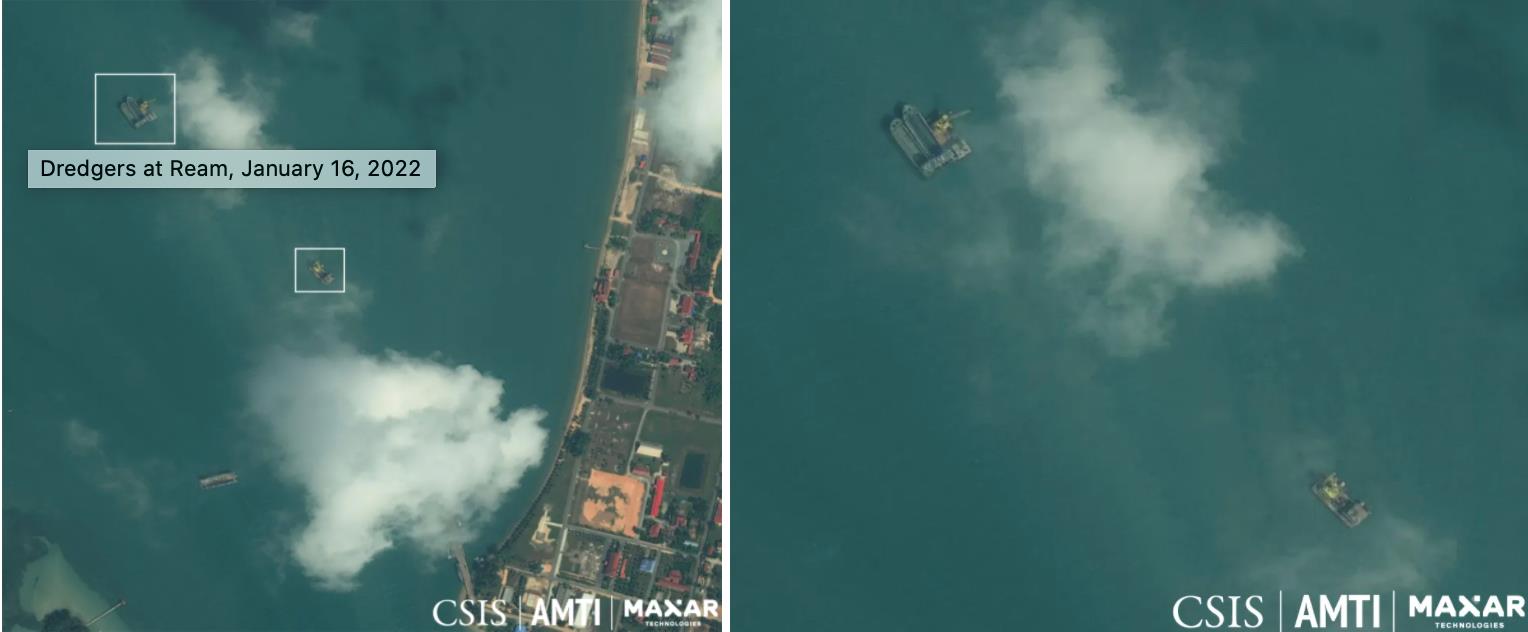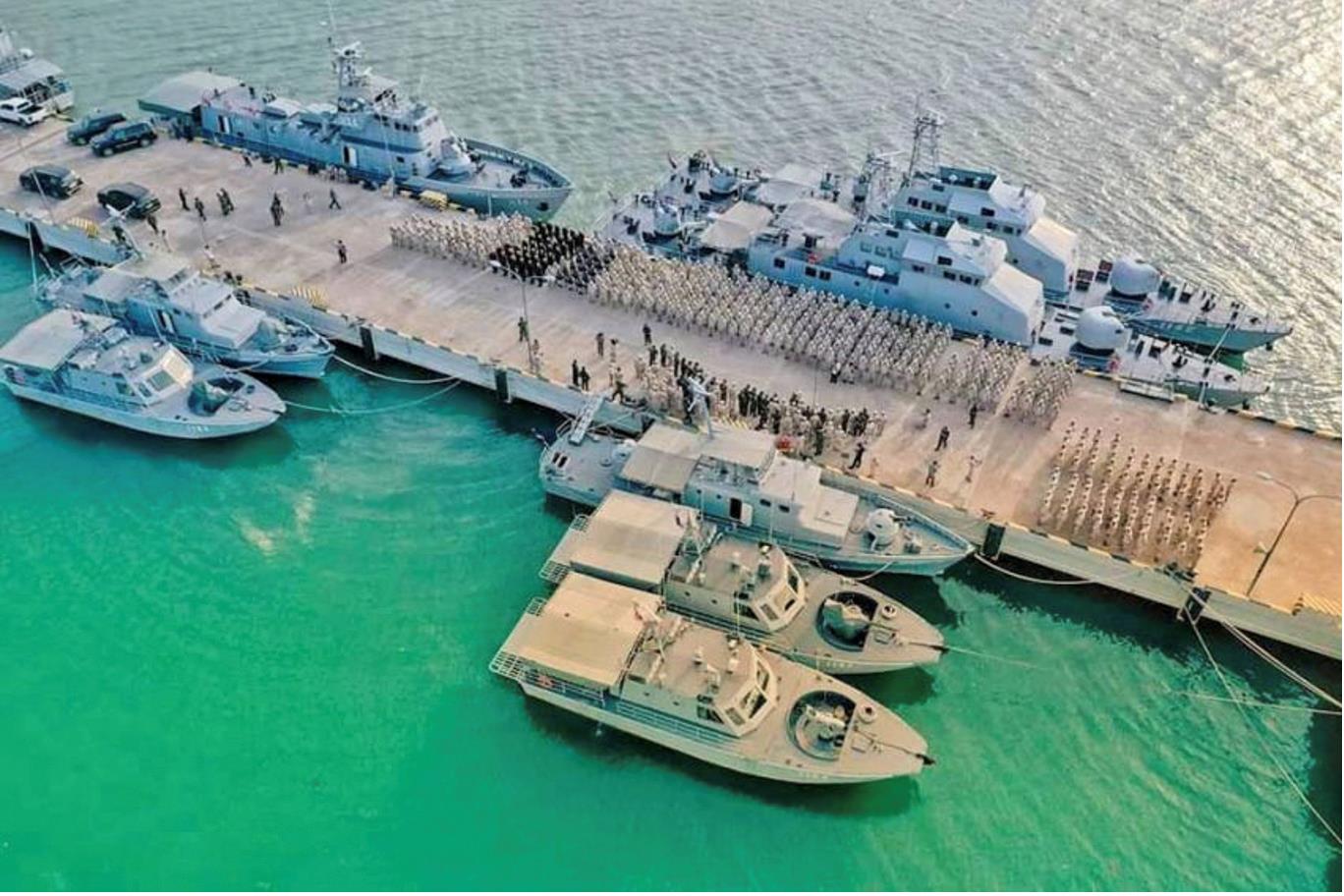(MENAFN- Asia Times)
The Asia Maritime Transparency Initiative (AMTI) recently released satellite imagery of Chinese dredging work at Cambodia's Ream Naval Base to enable the docking of larger vessels, a move that jibes with reports that Beijing has been granted exclusive access to the strategically situated base.
Cambodian officials have confirmed that China is funding the dredging project , and acknowledged that it has funded a host of other infrastructure improvements at the military facility.
The imagery shows two clamshell dredgers just off the coast of Ream accompanied by barges for collecting the dredged sands, according to ATMI, a unit of the influential Center for Strategic and International Studies (CSIS) think tank in Washington DC. The dredgers first arrived between January 13-15 and have since remained fixed in their positions, the ATMI report said.
The report noted the dredging represents a potential significant upgrade as the base's shallow waters currently allow it to host only small patrol vessels and not major warships. The report also featured satellite imagery showing ongoing onshore construction work at the base, including clearing for roads and the development of concrete lots along the coast.
In 2020, Cambodia demolished its US-built Cambodian Navy tactical headquarters facility at Ream, raising US concerns that the demolition was connected to Cambodia's alleged 2019 secret agreement to host Chinese naval assets and military personnel at the base.
Cambodian officials have consistently denied any such deal exists, which if so would violate legal provisions barring the stationing of foreign troops on Cambodian soil.

Satellite images of Chinese dredgers at Cambodia's Ream Naval Base. Images: ATMI/CSIS via Maxar
A potential Chinese naval presence at Cambodia's Ream base would allow China to balance against the US in the Malacca Strait chokepoint, secure its emerging interests in the Gulf of Thailand and establish a southern flank on the South China Sea. In addition, Cambodia can use China's naval presence as insurance against long-simmering threats from neighboring Thailand and Vietnam.
Significantly, a naval presence at Ream would give China a forward naval presence closer to the Malacca Strait to counterbalance, monitor and even potentially pre-empt against the US naval presence in Singapore . The US has a logistics base in Singapore that hosts rotational deployments of littoral combat ships (LCS) and P-8 Poseidon maritime patrol aircraft.
China's possible future naval presence at Ream may be crucial in solving its“Malacca Dilemma”, wherein its dependence on the Malacca Strait waterway for the passage of its trade, including in the past as much as 80% of its fuel imports from the Middle East, makes it vulnerable to a US naval blockade in a conflict scenario.
China's development of the Kyaukphyu deep-sea port in Myanmar provides one hedge against the Malacca Strait through the China-Myanmar Economic Corridor, a highway and pipeline system connecting Kyaukphyu port to the southern landlocked Yunnan province in China.
However, the escalating insurgency in Myanmar, the junta's botched Covid-19 pandemic response, and the possibility of Myanmar becoming a failed state may have caused China to doubt Myanmar's capacity to secure its infrastructure projects in the country.
Thailand's long-proposed Kra canal and land bridge between the Andaman Sea and Gulf of Thailand would potentially offer an alternative, but Thai concerns of becoming a target of great power competition, massive costs, physical separation of the nation and environmental issues have kept the project on the drawing board despite Beijing's expressed interest.
The Thais have said they would only consider the project as a multinational undertaking, rather than one dominated by China.
China's potential naval presence at Ream would also bolster its position in the South China Sea, particularly vis-à-vis rival claimant Vietnam. Access to Ream combined with its southern naval bases would potentially allow it to envelop and overstretch Vietnam's limited naval, maritime militia and law enforcement agencies in a two-front campaign. This, in turn, would increase the odds of miscalculation leading to a potential lopsided confrontation.
Moreover, Indonesia might perceive China's Ream naval presence as another threat to its Natuna Islands. While Indonesia is not a direct claimant in the South China Sea, there is an overlap between Indonesia's exclusive economic zone (EEZ) and China's unilaterally proclaimed nine-dash line, with the Natuna Islands at the center of this overlap.
While China acknowledges Indonesia's sovereignty over the Natuna Islands, it has argued that the waters surrounding them are its“traditional fishing grounds.” Indonesia and China have already had confrontations at the Natuna Islands . A Chinese naval presence at Ream would thus further exacerbate maritime tensions between the two sides, and deepen the latter's involvement in the South China Sea disputes.

China is helping Cambodia to develop its Ream Naval Base. Image: Facebook
Cambodia could also view China's naval presence at Ream as insurance against its larger and stronger neighbors Thailand and Vietnam. Thailand and Cambodia are locked in a long-simmering maritime dispute involving oil and gas fields in the Gulf of Thailand that could escalate, particularly if Thailand's fuel supplies from neighboring Myanmar are jeopardized by that country's escalating armed conflict.
Vietnam and Cambodia have a long history of conflict, as Vietnam invaded Cambodia in 1979 and occupied the latter until 1989. More recently, Cambodia is pitted in a border dispute with Vietnam , with Cambodian activists claiming their country has been losing farmland to Vietnam, as the Cambodian government is demarcating borders based on a 1985 treaty signed during the Vietnamese occupation.
More potently, Vietnam recently established a new maritime militia unit in its Kiem Giang province bordering Cambodia's Kampot province in apparent response to growing Chinese influence in Cambodia – and perhaps in anticipation of China's possible naval deployments at Ream.
Cambodia's potential dependence on China's possible naval presence at Ream as insurance against Thailand and Vietnam has implications for Cambodia's position in ASEAN. Cambodia blocked ASEAN from issuing a joint statement in 2012 and 2016 over the South China Sea disputes, where China is locked in simmering confrontations with the Philippines, Malaysia and Vietnam.
This has led to accusations that Cambodia is acting on behalf of China's interests in ASEAN, in return for economic and possibly security guarantees. That, in turn, has led to the erosion of ASEAN's credibility as a regional security conductor, a reputation which was already in doubt due to its inability to forge a united position on the South China Sea and its ineffective responses to the Rohingya refugee crisis and Myanmar coup.
MENAFN24012022000159011032ID1103585467
Legal Disclaimer:
MENAFN provides the information “as is” without warranty of any kind. We do not accept any responsibility or liability for the accuracy, content, images, videos, licenses, completeness, legality, or reliability of the information contained in this article. If you have any complaints or copyright issues related to this article, kindly contact the provider above.